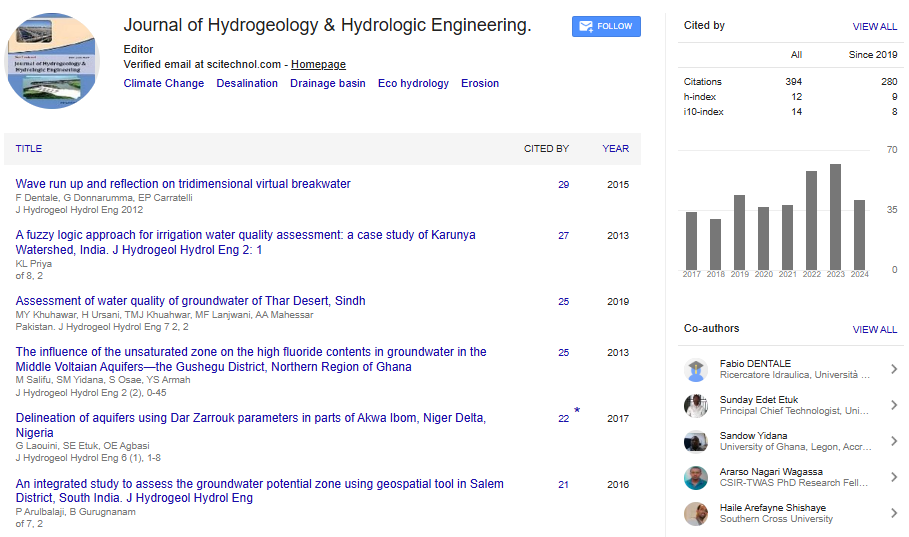Commentary, J Hydrogeol Hydrol Eng Vol: 13 Issue: 3
The Importance of Ground Water Retention for Sustainable Water Management
Anton Urfels*
1Department of Geology, University of New South Wales, Sydney, Australia
*Corresponding Author: Anton Urfels,
Department of Geology, University of New
South Wales, Sydney, Australia
E-mail: urfelsa39@gmail.com
Received date: 27 May, 2024, Manuscript No. JHHE-24-144604;
Editor assigned date: 30 May, 2024, PreQC No. JHHE-24-144604 (PQ);
Reviewed date: 13 June, 2024, QC No. JHHE-24-144604;
Revised date: 21 June, 2024, Manuscript No. JHHE-24-144604 (R);
Published date: 28 June, 2024, DOI: 10.4172/2325-9647.1000325
Citation: Urfels A (2024) The Importance of Ground Water Retention for Sustainable Water Management. J Hydrogeol Hydrol Eng 13:3.
Description
Groundwater retention is a precarious aspect of sustainable water management. It refers to the ability of underground aquifers to store and retain water, which can be tapped into for various uses such as drinking water, irrigation, and industrial processes. This natural reservoir plays an essential role in maintaining the balance of the ecosystem, supporting agriculture, and ensuring the availability of water during dry periods. As climate change and human activities continue to strain water resources, understanding and improving groundwater retention is becoming increasingly important. Groundwater serves as a vital source of fresh water for many communities around the world. It provides a reliable supply of water, especially in areas where surface water sources are scarce or seasonally variable. Groundwater is less susceptible to evaporation compared to surface water, making it a more stable and long-term resource. Additionally, during periods of drought, groundwater can act as a buffer, supplying essential water when surface sources run dry.
The type of soil and its structure play a significant role in groundwater retention. Sandy soils, for instance, have larger pore spaces and allow water to percolate quickly, reducing retention time. Clay soils, on the other hand, have smaller pore spaces that hold water longer. Plants and trees help in groundwater recharge through processes like transpiration and root penetration, which enhance soil porosity and water infiltration. Areas with dense vegetation typically have better groundwater retention compared to barren lands. The properties of the aquifer, including its porosity and permeability, determine how much water it can store and how quickly water can move through it. Confined aquifers, which are trapped between impermeable layers of rock, can store significant amounts of water. Urbanization, agriculture, and industrial activities can impact groundwater retention. Over-extraction of groundwater for irrigation, industrial processes, or drinking water can deplete aquifers. Land use changes, such as deforestation and construction, can reduce natural recharge areas, limiting groundwater replenishment.
Excessive pumping of groundwater for agricultural, industrial, and domestic use can lead to a decline in water levels, reducing the retention capacity of aquifers. In many regions, groundwater is being extracted faster than it can be naturally replenished. Contamination of groundwater from agricultural runoff, industrial discharge, and improper waste disposal can degrade water quality, making it unsuitable for use and reducing the effective storage capacity of aquifers. Changes in precipitation patterns, increased frequency of droughts, and higher temperatures can impact groundwater recharge rates. Reduced snowfall and earlier snowmelt can also affect the timing and availability of water for recharge. Urbanization and deforestation reduce the natural recharge areas for groundwater. Impervious surfaces like roads and buildings prevent water from infiltrating the soil, leading to reduced groundwater recharge.
Promoting water conservation practices in agriculture, industry, and households can reduce the demand on groundwater resources. Efficient irrigation techniques, such as drip irrigation, can minimize water use and reduce groundwater extraction. Constructing recharge structures like check dams, percolation tanks, and infiltration basins can help increase groundwater recharge. These structures capture surface runoff and allow it to percolate into the ground. Reforesting and planting vegetation in catchment areas can enhance groundwater recharge by improving soil structure and increasing water infiltration. Maintaining wetlands and riparian zones also contributes to groundwater retention. Implementing strict regulations on waste disposal and industrial discharge can help prevent groundwater contamination. Sustainable agricultural practices, such as reduced use of fertilizers and pesticides, can also protect groundwater quality. Developing and enforcing policies for sustainable groundwater extraction is essential. Monitoring groundwater levels, regulating extraction rates, and implementing recharge projects can help maintain the balance between groundwater use and replenishment.
Conclusion
Groundwater retention is essential for sustainable water management, providing a reliable and long-term source of fresh water. As pressures on water resources continue to grow, it is essential to understand and address the factors affecting groundwater retention. By implementing effective strategies for conservation, recharge enhancement, vegetation restoration, pollution control, and sustainable management, we can ensure the availability of groundwater for future generations and maintain the health of our ecosystems.
 Spanish
Spanish  Chinese
Chinese  Russian
Russian  German
German  French
French  Japanese
Japanese  Portuguese
Portuguese  Hindi
Hindi 
